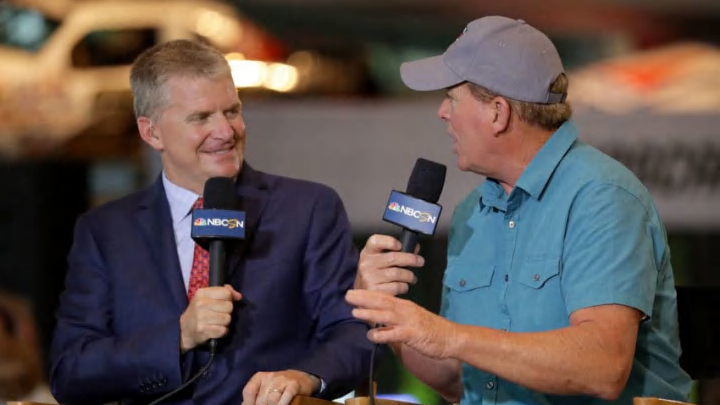The former NASCAR Cup Series driver would like us all to remember that fans voting with their wallets speaks louder than any other factor.
It’s not correct to label the call for more short tracks on the NASCAR schedule as the solution du jour for getting stock car racing out of its current doldrums, because some fans and media members have been saying that for some time. The drumbeat is simply louder now because drivers have been more vocal about it this year too. Jeff Burton, though, isn’t quite as convinced.
This week, the NBC Sports commentator provided a pretty interesting alternate point of view on the current debate. Burton noted that anything that means less variety in terms of the types of tracks NASCAR visits is a bad thing. Instead, the focus should be on making the racing better on the tracks that fans seem to like the least, namely the intermediate ovals that always seem to (for good reason in some cases) bear the brunt of the backlash against unexciting racing.
It’s not hard to see his point. One of the things that irks many fans the most about the intermediate tracks is not just that they exist, but that there are simply too many races on them each season. Swapping, say, eight of those races for eight more short track events is simply loading up on a different type of racing, and while some people would be willing to live with that trade-off, it wouldn’t likely stop the complaining about what happens on the 1.5-mile ovals. Getting rid of intermediate tracks altogether isn’t feasible for logistical reasons, and as Burton suggests, would rob the sport of some of the diversity of excellence that championship teams have to display.
That wasn’t the most interesting or potentially controversial part of Burton’s comments, though. Addressing the removal of historic tracks like Rockingham and North Wilkesboro from the schedule for the so-called cookie-cutter circuits like Chicagoland, Kansas and Las Vegas, he pointed out that maybe NASCAR fans have to shoulder some of the blame.
"Rockingham wasn’t exactly full when we left. There were a lot of empty seats in the grandstands. … Let’s don’t reinvent history and say these places were packed and the fans loved it, because fans were not going there and they were packing Chicago and Kansas and Texas.Let’s don’t confuse history and say the sport left those tracks. Those tracks had a role — and the fans had a role in not showing up."
That’s some hard medicine to digest, but it’s directly relevant to the “more short tracks” debate. From an overall business sense, NASCAR is going to run wherever it makes the most money to do so. If it could be sure that fans would pack the stands with more short track dates, you’d best believe it would add more of them as soon as the current track contracts — a significant factor in any changes to the schedule that can’t ever be overlooked — expire.
More from NASCAR
- NASCAR rain delay today, July 2 update: Chicago Street Race
- Where is the NASCAR course in Chicago? A look at how the Grant Park 220 will work
- Grant Park 220 Ticket prices: How much does it cost to attend?
- LAST CHANCE: FanDuel’s Crazy $2,500 Bonus NASCAR Promo Expires Sunday
- Trevor, start your engine: Jaguars’ temporary stadium could be NASCAR mecca
Recent history would suggest that it can’t assume that would be the case. The Bristol night race used to be one of the toughest tickets in all of professional sports, something you’d need to be on a wait list to get. This year’s race was definitely not sold out, though veteran journalists estimate there were 95,000 people in the stands, and that’s a heck of a lot by today’s standards. There’s a good chance only the Daytona 500 had more people in attendance at a NASCAR race this year.
There’s reason to believe that fans would come out and pack, say, Iowa Speedway if it got a Cup Series date. However, that track currently holds only 30,000 people, which is still less than other places NASCAR goes even if the stands are half-full.
All of this is a long-winded way of saying that with all things during the current era of NASCAR, one where attendance and TV ratings have been sagging, there are no easy answers, no one silver bullet that can eliminate apathy in a single shot. More short track races might be part of the solution, but Burton is right that making the racing more exciting at other places is also crucial, and that fans backing up their professed desires maybe even more so.
That’s probably not the answer anyone would like to hear when it’s so tempting to think that “more Bristols” would work just fine, but it’s almost certainly the truth.
